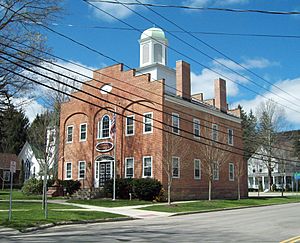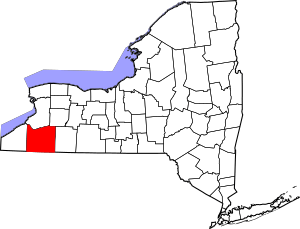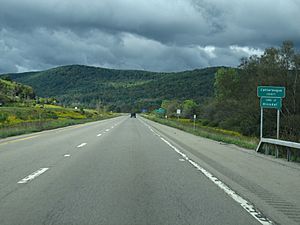Cattaraugus County, New York facts for kids
Quick facts for kids
Cattaraugus County
|
|||
|---|---|---|---|

|
|||
|
|||

Location within the U.S. state of New York
|
|||
 New York's location within the U.S. |
|||
| Country | |||
| State | |||
| Founded | March 28, 1817 | ||
| Seat | Little Valley | ||
| Largest city | Olean | ||
| Area | |||
| • Total | 1,322 sq mi (3,420 km2) | ||
| • Land | 1,308 sq mi (3,390 km2) | ||
| • Water | 14 sq mi (40 km2) 1.1% | ||
| Population
(2020)
|
|||
| • Total | 77,042 |
||
| • Density | 58.9/sq mi (22.7/km2) | ||
| Time zone | UTC−5 (Eastern) | ||
| • Summer (DST) | UTC−4 (EDT) | ||
| Congressional district | 23rd | ||
Cattaraugus County, often called Catt County, is a county in Western New York. One side of the county borders the state of Pennsylvania. In 2020, about 77,042 people lived here. The main town, or county seat, is Little Valley.
The county was first created in 1808 and officially started its government in 1817. It is part of the larger Western New York area. Cattaraugus County is also part of a bigger group of cities and towns around Buffalo. Inside the county, you'll find the Allegany Indian Reservation of the Seneca Nation of New York. You can also visit the large Allegany State Park. The Allegheny River flows through the county too.
Contents
- History of Cattaraugus County
- Geography of Cattaraugus County
- Transportation in Cattaraugus County
- Population of Cattaraugus County
- Fun Facts About Cattaraugus County
- Media in Cattaraugus County
- Education in Cattaraugus County
- Communities in Cattaraugus County
- Notable People from Cattaraugus County
- See also
History of Cattaraugus County
Long ago, this land was the home of the Wenrohronon Native American people. Later, it became the territory of the Seneca people. The Seneca are one of the five original nations of the Haudenosaunee.
Early Claims and County Changes
During the time when America was still a group of colonies, three different colonies claimed this land. These were New York Colony, Massachusetts Bay Colony, and Province of Pennsylvania. They all claimed land stretching far to the west.
When New York first set up its counties in 1683, Cattaraugus County was part of a huge area called Albany County. This county was so big it covered much of northern New York and even parts of what is now Vermont. Over time, as more people settled, Albany County was split into smaller counties.
In 1772, Albany County was divided again. A new county called Tryon County was formed. This county included the western part of New York. It was named after William Tryon, who was the governor of New York at the time.
After the American Revolutionary War, the name of Tryon County was changed. In 1784, it became Montgomery County. This was to honor General Richard Montgomery, a hero of the war.
Native American Lands and New Settlements
For a while, much of this area was an "Indian Reserve." This land was set aside for Native Americans by the British. After the United States became independent, new treaties were made. The Treaty of Canandaigua in 1794 set up several reservations for Native Americans. Three of these reservations are partly in what is now Cattaraugus County.
More European-American settlers began to arrive in Western New York. In 1789, Ontario County was created from Montgomery County. Then, in 1802, Genesee County was formed from Ontario County.
Forming Cattaraugus County
Cattaraugus County was officially created in 1808. It was split off from Genesee County. At first, there weren't enough people to have a county government. For a few years, its records were kept in other counties.
The name "Cattaraugus" comes from a Seneca word. It means "bad smelling banks." This refers to the smell of natural gas that leaks from the ground. In 1817, Cattaraugus County finally set up its own government. The first county seat was in a town now called Ellicottville.
Many towns in the county are named after people from the Holland Land Company. This company helped sell land in the area. For example, Ellicottville is named after Joseph Ellicott.
The very first settlement in the county was in Olean. Later, around 1860, the county seat moved to Little Valley. This happened because a railroad was built there.
Today, the Allegany Indian Reservation is still within the county. It is one of two main areas for the Seneca Nation of New York. South of Salamanca, New York, which is a city inside the reservation, you'll find Allegany State Park. This park connects to the Allegheny National Forest in Pennsylvania.
Geography of Cattaraugus County
Cattaraugus County covers about 1,322 square miles. Most of this is land, with about 14 square miles of water. It is in the southwestern part of New York, right above the Pennsylvania border.
The southern part of the county looks very rugged. This is because it was not covered by the last ice age. The rest of Western New York was smoothed out by glaciers. The county has many hills and valleys. These are part of the Allegany Plateau. This area is sometimes called the Enchanted Mountains because of its mountain-like peaks.
The southern part of the county used to have a lot of petroleum (oil). Now, most of that oil is gone. But natural gas is still taken from the ground. A special line called a continental divide runs through the county. This line separates rivers that flow to the Mississippi River from those that flow to the Great Lakes. The northern border of the county is formed by Cattaraugus Creek. The Allegheny River also flows through the county.
Important Geographic Features
Mountains
- Mount Tuscarora
- Mount Three Sisters
- Mount Seneca
- Mount Cayuga
- Mount Onondaga
- Mount Oneida
- Mount Mohawk
- Blacksnake Mountain
- Mount Irvine
- McCarty Hill
- Hartzfelt Mountain
- Mount Hermanns
Lakes
Rivers and Streams
- Allegheny River
- Ischua Creek
- Tunungwant Creek
- Bailley Brook
- Leonard Run
- Limestone Run
- Harrisburg Run
- Great Valley Creek
- Little Valley Creek
- Red House Brook
- Conewango Creek
- Cattaraugus Creek
- Cattaraugus Creek South Branch
Neighboring Counties
- Erie County - north
- Wyoming County - northeast
- Allegany County - east
- McKean County, Pennsylvania - southeast
- Warren County, Pennsylvania - southwest
- Chautauqua County - west
Transportation in Cattaraugus County
Main Roads


 I-86 / NY 17 / Southern Tier Expressway
I-86 / NY 17 / Southern Tier Expressway U.S. Route 62
U.S. Route 62 U.S. Route 219
U.S. Route 219 New York State Route 16
New York State Route 16 New York State Route 98
New York State Route 98 New York State Route 240
New York State Route 240 New York State Route 242
New York State Route 242 New York State Route 353
New York State Route 353 New York State Route 417
New York State Route 417
Airports
There are two airports in Cattaraugus County. Great Valley Airport is near Great Valley. The Cattaraugus County-Olean Airport is located near Olean.
Bus Services
You can find bus service through Coach USA. This bus line connects towns like Jamestown and Olean. It also offers connections to Buffalo and New York City. Another company, Trailways, has a daily bus route from Buffalo to Pennsylvania.
The county does not have one big public bus system. However, the Seneca Nation has its own bus line. This line connects its different reservations. There is also the Olean Area Transit System. It connects the cities of Salamanca and Olean.
Train Services
There are no regular passenger trains in Cattaraugus County. Amtrak trains do not stop here. However, freight trains do operate in the county. The WNY & PA Railroad carries goods. The New York and Lake Erie Railroad and the Buffalo and Pittsburgh Railroad also provide freight service.
Population of Cattaraugus County
| Historical population | |||
|---|---|---|---|
| Census | Pop. | %± | |
| 1820 | 4,090 | — | |
| 1830 | 16,724 | 308.9% | |
| 1840 | 28,872 | 72.6% | |
| 1850 | 38,950 | 34.9% | |
| 1860 | 43,886 | 12.7% | |
| 1870 | 43,909 | 0.1% | |
| 1880 | 55,806 | 27.1% | |
| 1890 | 60,866 | 9.1% | |
| 1900 | 65,643 | 7.8% | |
| 1910 | 65,919 | 0.4% | |
| 1920 | 71,323 | 8.2% | |
| 1930 | 72,398 | 1.5% | |
| 1940 | 72,652 | 0.4% | |
| 1950 | 77,901 | 7.2% | |
| 1960 | 80,187 | 2.9% | |
| 1970 | 81,666 | 1.8% | |
| 1980 | 85,697 | 4.9% | |
| 1990 | 84,234 | −1.7% | |
| 2000 | 83,955 | −0.3% | |
| 2010 | 80,343 | −4.3% | |
| 2020 | 77,042 | −4.1% | |
| U.S. Decennial Census 1790-1960 1900-1990 1990-2000 2010-2020 |
|||
2020 Census Information
The 2020 Census showed the different groups of people living in Cattaraugus County:
| Race | Number | Percentage |
|---|---|---|
| White | 67,554 | 87.68% |
| Black or African American | 996 | 1.29% |
| Native American | 2,261 | 3.45% |
| Asian | 560 | 0.72% |
| Pacific Islander | 9 | 0.01% |
| Other/Mixed | 3,647 | 4.73% |
| Hispanic or Latino | 1,615 | 2.09% |
Fun Facts About Cattaraugus County
There are two cool rock formations in the county called "Rock City." They look like a town with streets! One is in Olean and the other in Little Valley.
Olean is the biggest city in the county. It's a major place for businesses. The county is also known for its "Ski Country." Two popular ski resorts, Holiday Valley Resort and HoliMont, are in Ellicottville. Many people from Canada visit these resorts. There are also many snowmobile trails, like the Pat McGee Trail.
Cattaraugus County is part of a region called Appalachia. It's also part of Western New York and the Southern Tier. Because of its location, people in the county speak with different accents.
The sales tax in Cattaraugus County is 8%. This includes 4% from New York State and 4% from the county.
A large Amish community lives in the western part of the county. There are about 2,500 Amish residents. This is almost 3% of the county's population. Some of these Amish families live a very traditional way. They do not use indoor plumbing. This, along with some Seneca families who live traditionally, means the county has more homes without indoor plumbing than nearby areas.
Media in Cattaraugus County
Newspapers
- Salamanca Press (weekly)
- Olean Times Herald (daily)
- Olean Source (free weekly)
- Franklinville Mercury-Gazette (free weekly)
- The Villager (free weekly, from Ellicottville)
- Randolph Register (monthly)
- Ellicottville Snowed In / The Summer Local (monthly)
- Gowanda—Silver Creek Pennysaver (weekly)
- Pennysaver News (weekly)
Radio Stations
- WPIG (95.7, Olean)
- WOLY (1450, Olean)
- WOLN (91.3, Olean)
- WQRS (98.3, Salamanca)
- WGGO (1590, Salamanca)
- WOEN (1360, Olean)
- WMXO (101.5, Olean)
- WSBU (88.3, St. Bonaventure)
- WTWT (90.5, Allegany)
- WCGB (91.9, Franklinville)
- WCGS (105.9, Little Valley)
Television Stations
- WWHC-LD (Ch. 20, Olean)
- WVTT-CD (Ch. 25, Olean)
- WBUO-LD (Ch. 30, Olean)
Education in Cattaraugus County
For higher education, there's a branch of Jamestown Community College in Olean. Jamestown Business College also has a campus in Salamanca. Cornplanter College, a college run by a Native American tribe, opened in 2014 in Salamanca. St. Bonaventure University is located near Olean.
Here are the K-12 school districts in the county:
- Allegany-Limestone Central School District
- Cattaraugus-Little Valley Central School District
- Cuba-Rushford Central School District
- Ellicottville Central School District
- Forestville Central School District
- Franklinville Central School District
- Frewsburg Central School District
- Gowanda Central School District
- Hinsdale Central School District
- Olean City School District
- Pine Valley Central School District (South Dayton)
- Portville Central School District
- Randolph Central School District
- Salamanca City School District
- Springville-Griffith Institute Central School
- West Valley Central School District
- Yorkshire-Pioneer Central School District
The Randolph Academy Union Free School District also helps care for children in the county.
Communities in Cattaraugus County
Largest Settlements
| # | Location | Population | Type | Sector |
|---|---|---|---|---|
| 1 | Olean | 13,437 | City | Southeast |
| 2 | Salamanca | 5,929 | City | Southwest |
| 3 | ‡Gowanda | 2,709 | Village | Northwest |
| 4 | St. Bonaventure | 2,044 | CDP | Southeast |
| 5 | Allegany | 1,816 | Village | Southeast |
| 6 | Franklinville | 1,740 | Village | Northeast |
| 7 | Weston Mills | 1,472 | CDP/Hamlet | Southeast |
| 8 | ††Randolph | 1,286 | CDP/Hamlet | Southwest |
| 9 | Yorkshire | 1,180 | CDP | Northeast |
| 10 | †Little Valley | 1,143 | Village | Northwest |
| 11 | Delevan | 1,089 | Village | Northeast |
| 12 | Portville | 1,014 | Village | Southeast |
| 13 | Cattaraugus | 1,002 | Village | Northwest |
| 14 | Lime Lake | 867 | CDP | Northeast |
| 15 | ††East Randolph | 620 | CDP/Hamlet | Southwest |
| 15 | South Dayton | 620 | Village | Northwest |
| 17 | West Valley | 518 | CDP | Northeast |
| 18 | Machias | 471 | CDP | Northeast |
| 19 | ††Perrysburg | 401 | CDP | Northwest |
| 20 | ††Limestone | 389 | CDP/Hamlet | Southeast |
| 21 | Ellicottville | 376 | Village | Northeast |
†† - Former Village
† - County Seat
‡ - Not Wholly in this county
Towns
- Allegany
- Ashford
- Carrollton
- Coldspring
- Conewango
- Dayton
- East Otto
- Ellicottville
- Farmersville
- Franklinville
- Freedom
- Great Valley
- Hinsdale
- Humphrey
- Ischua
- Leon
- Little Valley
- Lyndon
- Machias
- Mansfield
- Napoli
- New Albion
- Olean
- Otto
- Perrysburg
- Persia
- Portville
- Randolph
- Red House
- Salamanca
- South Valley
- Yorkshire
Small Communities (Hamlets)
- Bedford Corners
- Farmersville Station
- Jimerson Town
- Kill Buck
- Sandusky
- Steamburg
- Versailles
Native American Reservations
Notable People from Cattaraugus County
- Bill Bergey, professional football player
- Governor Blacksnake, Seneca war chief
- Ray Caldwell, MLB pitcher
- William R. Case, founder of a knife company
- Anna Botsford Comstock, artist and professor
- Chuck Crist, professional football player
- Carlos L. Douglass, farmer and politician
- Brian Dunkleman, TV host
- Ray Evans, famous songwriter
- Ira Joe Fisher, poet and TV weatherman
- James F. Hastings, former U.S. Congressman
- William C. Hayward, Iowa Secretary of State
- Marvin "Marv" Hubbard, professional football player
- Timothy Kellner, U.S. Army Staff Sergeant
- Riki Lindhome, actress and musician
- Ted Marchibroda, NFL Head Coach
- Paul Owens, professional baseball player and manager
- Terrence Pegula, businessman and sports investor
- Kimberly Pressler, Miss USA 1999
- Isaac Seneca, professional football player
- Margaret Shulock, cartoonist
- Peter Tomarken, TV game show host
- Lyman M. Ward, Union Army General
- Louis Zamperini, Olympic runner and WWII hero
See also
 In Spanish: Condado de Cattaraugus para niños
In Spanish: Condado de Cattaraugus para niños





